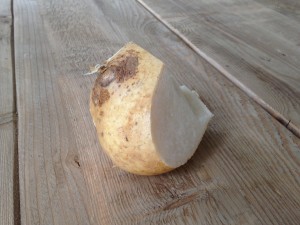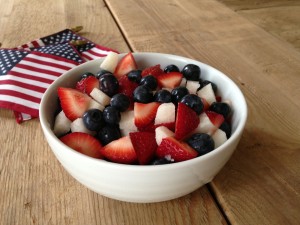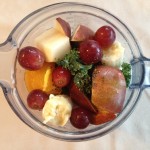We threw this little snack together this afternoon to celebrate the first day of July! The mixture consists of organic strawberries, organic blueberries and jicama.
Raw jicama has a sweet apple-like fruity taste and texture. It is a very low calorie root vegetable and contains only 35 calories per 100g. Jicama is one of the finest sources of dietary fiber and an excellent source of oligofructose inulin, a soluble dietary fiber. Inulin is a zero calorie, sweet, inert carbohydrate and does not metabolize in the human body, which makes the root an ideal sweet snack. Jicama is also rich in vitamin C, providing 34% of DRA (daily recommended allowance) of vitamin C per 100g. Vitamin C is a powerful water-soluble antioxidant that helps the body sweep away harmful free radicals, thereby offering protection from cancers, inflammation and viral coughs & colds. It also contains small levels of valuable B-complex vitamins such as folates, riboflavin, pyridoxine, pantothenic acid and thiamin. Further, it provides healthy amounts of some important minerals like magnesium, copper, iron and manganese.
Jicamas are generally available year-round. Choose well-formed, firm, round, medium-sized jicamas. Avoid soft, shriveled, or ones with surface cuts, cracks and bruised skin. Jicamas can be stored like potatoes. They have very good shelf life and keep well in a cool, dry, dark place for about 3-4 weeks.
When ready to use, wash in cool running water. Peel skin using a vegetable peeler or paring knife. The peel and other plant parts contain rotenene, an odorless, colorless chemical compound used as a broad-spectrum insecticide and pesticide; and therefore, should be discarded. It then can be cut into cubes, sliced, or chopped to fine sticks. It stays crisp when cooked, making it wonderful in stir-fries.
Strawberries are always on the list of dirty dozen foods, in part because fungus prompts farmers to spray, and pesticide residue remains on berries sold in the grocery store. Nearly 60 different pesticides have been found on fresh strawberries. If you can’t find organic strawberries, safer alternatives are kiwis and pineapples. When purchasing your pineapples, do not purchase Del Monte varieties from Costa Rica as they are at risk of being genetically modified. There is usually a tag on the pineapple that tells you where it is from.
It is best to purchase organic blueberries because they usually make the dirty dozen list, since more than 50 pesticides have been detected as residue on them. Unfortunately, obvious alternatives like cranberries and cherries, while they may not make the dirty dozen list this year, are often contaminated themselves. – Information provided by: The Daily Green.
Strawberries and blueberries contain ellagic acid (plant chemical) and a large number of polyphenols (anti-oxidants). “Ellagic acid seems to have some anti-cancer properties. It can act as an anti-oxidant, and has been found to cause cell death in cancer cells in the laboratory. In other laboratory studies, ellagic acid seems to reduce the effect of estrogen in promoting growth of breast cancer cells in tissue cultures. There are also reports that it may help the liver to break down or remove some cancer-causing substances from the blood. Ellagic acid has also been said to reduce heart disease, birth defects, liver problems, and to promote wound healing.” – Information provided by cancer.org
To receive daily health tips and gluten-free, grain-free, dairy-free and sugar-free meal/snack ideas, like us at www.facebook.com/wholefoodrealfood.
“When you know better, you do better.”




